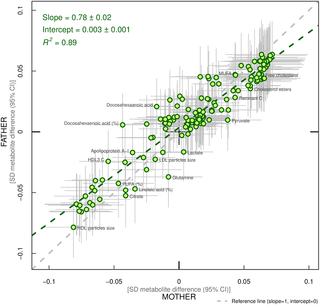PLOS Medicine ( IF 10.5 ) Pub Date : 2017-08-22 , DOI: 10.1371/journal.pmed.1002376 Diana L Santos Ferreira 1, 2 , Dylan M Williams 3, 4 , Antti J Kangas 5, 6 , Pasi Soininen 5, 6, 7 , Mika Ala-Korpela 1, 2, 5, 6, 7 , George Davey Smith 1, 2 , Marjo-Riitta Jarvelin 3, 6, 8, 9 , Debbie A Lawlor 1, 2

|
Background
A high proportion of women start pregnancy overweight or obese. According to the developmental overnutrition hypothesis, this could lead offspring to have metabolic disruption throughout their lives and thus perpetuate the obesity epidemic across generations. Concerns about this hypothesis are influencing antenatal care. However, it is unknown whether maternal pregnancy adiposity is associated with long-term risk of adverse metabolic profiles in offspring, and if so, whether this association is causal, via intrauterine mechanisms, or explained by shared familial (genetic, lifestyle, socioeconomic) characteristics. We aimed to determine if associations between maternal body mass index (BMI) and offspring systemic cardio-metabolic profile are causal, via intrauterine mechanisms, or due to shared familial factors.
Methods and findings
We used 1- and 2-stage individual participant data (IPD) meta-analysis, and a negative-control (paternal BMI) to examine the association between maternal pre-pregnancy BMI and offspring serum metabolome from 3 European birth cohorts (offspring age at blood collection: 16, 17, and 31 years). Circulating metabolic traits were quantified by high-throughput nuclear magnetic resonance metabolomics. Results from 1-stage IPD meta-analysis (N = 5327 to 5377 mother-father-offspring trios) showed that increasing maternal and paternal BMI was associated with an adverse cardio-metabolic profile in offspring. We observed strong positive associations with very-low-density lipoprotein (VLDL)-lipoproteins, VLDL-cholesterol (C), VLDL-triglycerides, VLDL-diameter, branched/aromatic amino acids, glycoprotein acetyls, and triglycerides, and strong negative associations with high-density lipoprotein (HDL), HDL-diameter, HDL-C, HDL2-C, and HDL3-C (all P < 0.003). Slightly stronger magnitudes of associations were present for maternal compared with paternal BMI across these associations; however, there was no strong statistical evidence for heterogeneity between them (all bootstrap P > 0.003, equivalent to P > 0.05 after accounting for multiple testing). Results were similar in each individual cohort, and in the 2-stage analysis. Offspring BMI showed similar patterns of cross-sectional association with metabolic profile as for parental pre-pregnancy BMI associations but with greater magnitudes. Adjustment of parental BMI–offspring metabolic traits associations for offspring BMI suggested the parental associations were largely due to the association of parental BMI with offspring BMI. Limitations of this study are that inferences cannot be drawn about the role of circulating maternal fetal fuels (i.e., glucose, lipids, fatty acids, and amino acids) on later offspring metabolic profile. In addition, BMI may not reflect potential effects of maternal pregnancy fat distribution.
Conclusion
Our findings suggest that maternal BMI–offspring metabolome associations are likely to be largely due to shared genetic or familial lifestyle confounding rather than to intrauterine mechanisms.
中文翻译:

孕前体重指数与后代代谢特征的关联:对 3 个欧洲前瞻性出生队列的分析
背景
很大比例的女性在怀孕时开始超重或肥胖。根据发育过度营养假说,这可能导致后代在其一生中发生代谢紊乱,从而使肥胖流行在几代人之间持续存在。对这一假设的担忧正在影响产前保健。然而,尚不清楚母体妊娠肥胖是否与后代不良代谢特征的长期风险相关,如果是,这种关联是否是因果关系,通过宫内机制,或由共同的家族(遗传、生活方式、社会经济)特征解释. 我们旨在确定母体体重指数 (BMI) 与后代全身心脏代谢谱之间的关联是通过宫内机制还是由于共同的家族因素造成的。
方法和发现
我们使用 1 阶段和 2 阶段个体参与者数据 (IPD) 荟萃分析和阴性对照(父亲 BMI)来检查母亲孕前 BMI 与来自 3 个欧洲出生队列的后代血清代谢组之间的关联(后代年龄为采血:16、17 和 31 岁)。通过高通量核磁共振代谢组学对循环代谢特征进行量化。1 阶段 IPD 荟萃分析的结果(N= 5327 至 5377 个母亲-父亲-后代三人组)表明,母亲和父亲 BMI 的增加与后代的不良心脏代谢特征相关。我们观察到与极低密度脂蛋白 (VLDL)-脂蛋白、VLDL-胆固醇 (C)、VLDL-甘油三酯、VLDL-直径、支链/芳香族氨基酸、糖蛋白乙酰基和甘油三酯有很强的正相关,而与高密度脂蛋白 (HDL)、HDL 直径、HDL-C、HDL 2 -C 和 HDL 3 -C(所有P < 0.003)。在这些关联中,与父亲 BMI 相比,母亲的关联程度略强;然而,没有强有力的统计证据表明它们之间存在异质性(所有 bootstrap P> 0.003,相当于经过多次检验后P > 0.05)。每个单独队列和两阶段分析的结果相似。后代 BMI 与代谢特征的横断面关联模式与父母孕前 BMI 关联的横截面关联模式相似,但幅度更大。对后代 BMI 的父母 BMI-后代代谢特征关联的调整表明,父母的关联主要是由于父母 BMI 与后代 BMI 的关联。本研究的局限性在于无法推断循环母体胎儿燃料(即葡萄糖、脂质、脂肪酸和氨基酸)对后代代谢谱的作用。此外,BMI 可能无法反映母体妊娠脂肪分布的潜在影响。
结论
我们的研究结果表明,母体 BMI-后代代谢组关联可能主要是由于共同的遗传或家庭生活方式混杂,而不是宫内机制。









































 京公网安备 11010802027423号
京公网安备 11010802027423号